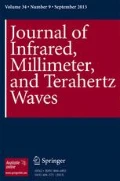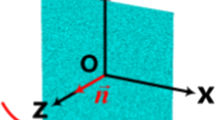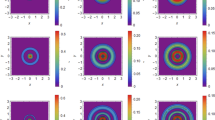Abstract
In RCS estimation, usually a plane wave is assumed; while in real measurements at terahertz frequencies, generally a Gaussian beam or a similar beam source is adopted. In this paper, the RCS of a conducting sphere is discussed under the condition that the incident wave is a Gaussian beam. In the estimation, the influence of 2.52 THz collimated laser beam on RCS is discussed and the RCS changing with scattering angle and some other factors is obtained; at the same time, the comparisons between different incident beams, plane wave and Gaussian beam, are also given. The estimation results show that choosing a beam width of 40 mm is appropriate when the sphere radius is 10 mm and the distance between the sphere and the beam source is 1 m.







Similar content being viewed by others
References
Albert Redo-Sanchez, and Xi-Cheng Zhang, “Terahertz Science and Technology Trends,” IEEE J. Sel. Top. Quant. Elect., 14, 260-269 (2008).
Krzysztof Iwaszczuk, Henning Heiselberg, Peter Uhd Jepsen. “Terahertz Radar Cross Section Measurements,” Optics Express, 18(25), 26399~26408(2010).
M. A. Salhi, I. Pupeza, and Martin Koch. “Confocal THz Laser Microscope,” J. Infrared Milli Terahz Waves, 31(3), 358~366(2010).
E. Pickwell, and V. P. Wallace, “Biomedical Applications of Terahertz Technology,” J. Phys. D: Appl. Phys., 39, R301-R310 (2006)
C. Jansen, N. Krumbholz, R. Geisb et al.. “Alignment and Illumination Issues in Scaled THz RCS Measurements,” 34th International Conference on Infrared, Millimeter, and Terahertz Waves, IRMMW-THz (2009).
Haruo Sakurai, Makoto Ohki, Kuniyuki Motojima et al.. “Scattering of Gaussian Beam from a Hemispherical Boss on a Conducting Plane,” IEEE Trans. Antennas Propaga., 52(3):892~894(2004).
Hyo J. Eom, Gui Y. Hur, Tah J. Park et al.. “Gaussian Beam Scattering from a Semicircular Boss above a Conducting Plane,”G. IEEE Trans. Antennas Propaga., 41(1):106~108(1993).
W. C. Tasi and R. J. Pogorzelski. “Eigenfunction Solution of the Scattering of Beam Radiation Fields by Spherical Objects,” Opt. Soc. Am., 65(12): 1457~1463 (1975).
W. G. Tam and R. Corriveau. “Scattering of Electromagnetic Beam by Spherical Object,” J. Opt. Soc. Am., 68(6):763~767(1978).
Eugene F. Knott. “Radar Handbook: Chapter 14 Radar Cross Section,” The McGraw-Hill Companies, (2008).
Author information
Authors and Affiliations
Corresponding author
Rights and permissions
About this article
Cite this article
Li, HY., Li, Q., Xia, ZW. et al. Influence of Gaussian Beam on Terahertz Radar Cross Section of a Conducting Sphere. J Infrared Milli Terahz Waves 34, 88–96 (2013). https://doi.org/10.1007/s10762-012-9950-6
Received:
Accepted:
Published:
Issue Date:
DOI: https://doi.org/10.1007/s10762-012-9950-6




